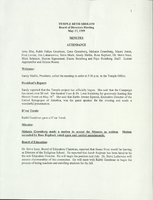Search the Special Collections and Archives Portal
Search Results
Stuntman Dan Koko jumps of Vegas World Hotel: video
Date
Archival Collection
Description
Local news segments and b-roll footage of two high-rise jumps that stuntman Dan Koko made from Bob Stupak's Vegas World Hotel structure in 1984. The first jump of 225 feet made on May 19, 1984; the second jump of world record acclaim of 326 feet, made on August 30, 1984. Clips include b-roll of the jumps, soundbites with Koko, and reporters interviewing Koko discussing his motivations for the jumps. Original media VHS, color, aspect ratio 4 x 3, frame size 720 x 486. From the Bob Stupak Professional Papers (MS-01016) -- Professional papers -- Audiovisual material -- Digitized audiovisual material file.
Moving Image
University of Nevada, Las Vegas University Parking and Traffic Control Committee Records
Identifier
Abstract
The University of Nevada, Las Vegas (UNLV) University Parking and Traffic Control Committee Records (1969-1992) contain meeting minutes, correspondence, reports, parking regulations, and newsletters. The UNLV Parking and Traffic Control Committee reviewed various policies and regulations for UNLV parking facilities and made recommendations for parking lot and traffic flow changes, as well as parking fines and permit fees.
Archival Collection
Frances Intravia Photograph Collection
Identifier
Abstract
The Frances Intravia Photograph Collection (approximately 1948 to 1979) contains three black-and-white photographic prints. The images depict Albert and Arabell Lee Hafner, author of 100 Years on the Muddy, visiting the St. Thomas, Nevada townsite after the Lake Mead water levels dropped enough make it visible. One of the prints is an original from approximately 1948 to 1952, and the other two are reproductions of images taken during the same period.
Archival Collection
Fraley Family Collection of Las Vegas, Nevada Films and Photographs
Identifier
Abstract
The Fraley Family Collection of Las Vegas, Nevada Films and Photographs (1956-1995) include 8mm photographic films of the Helldorado Parade and Hoover (Boulder) Dam in 1956, color photographic prints of the construction of the Fremont Street Experience in 1995, and one color photographic print of the Tower Casino at the State Line in 1976. The 8mm film footage was taken during a family vacation and also includes exterior shots of casinos on the Las Vegas Strip.
Archival Collection
Lincoln County Archaeological Initiative Collection
Identifier
Abstract
The Lincoln County Archaeological Initiative Collection (2016-2019) contains digital files of oral histories collected as part of A Ranching and Farming Context for Lincoln County, Nevada, ca. 1857 to 1934 (Oliver et al. 2018). The collection consists of thirteen digital oral history recordings and corresponding transcripts, as well as a final report of phase one of the project. The entire collection is digital files.
Archival Collection
Victor J. Zerga oral history interview
Identifier
Abstract
Oral history interview with Victor J. Zerga conducted by David Jukich on April 03, 1976 for the Ralph Roske Oral History Project on Early Las Vegas. Zerga gives insight into the field of nursing and discusses the role that ranching had in Las Vegas, Nevada.
Archival Collection
Marcus Mason oral history interview
Identifier
Abstract
Oral history interview with Marcus Mason conducted by Leon Green on February 04, 2013 for the African Americans in Las Vegas: a Collaborative Oral History Project. Mason talks about his childhood in Las Vegas, Nevada, his parents’ past occupations, and how his religious upbringing influenced his career choices as an adult.
Archival Collection

Transcript of interview with Billy Paul Smith by Claytee White, October 3, 2013
Date
Archival Collection
Description
Chemist, mathematician, and health physicist Billy Paul Smith donates time to tutor young people in hopes of attracting more youth into the fields of math and science. Born in 1942 and schooled in segregated black schools in Shreveport, Louisiana, and Texarkana, Texas, he graduated from high school at age fifteen and enrolled at Prairie View A&M University, where he trained with the Reserve Officer Training Corps (ROTC) and earned his Bachelor’s degree in chemistry and in 1964 his Master’s degrees in chemistry and math. Most young U.S. Army officers in 1964 went to Vietnam, but Billy’s math and science background steered him to the Army Chemical Corps, where he was quickly selected to join a new team. The team was to develop responses to nuclear weapon accidents and worked under the Defense Atomic Support Agency (DASA) in Albuquerque, New Mexico. At the same time, Billy completed the Weapons Ordinance Army course on classified information relating to the U.S. nuclear weapons arsenal. In this interview, Billy talks about his service with DASA and his subsequent twenty-seven years working at the Nevada Test Site in a variety of positions with Reynolds Electrical and Engineering Company, Inc. (REECo), a company that had “percentagewise more blacks in management positions than any other [Las Vegas] company.” He experienced the quiet racism of Las Vegas residential segregation when he tried to purchase a house in a neighborhood he liked and the unexpected kindness of the REECo general manager, Ron Keen, who made sure the Smith family could live where they wanted to live. He talks about Area 51 and explains underground testing activity and offers the scientific and ecological reasons why scientists deemed Yucca Mountain safe to store nuclear waste. After retiring at fifty-two, Billy and a colleague formed an independent instrumentation company, which, from 1995–2005 provided and calibrated radiological measurement and detection instruments for the decommissioning and closure of the Rocky Flats nuclear plant in Golden, Colorado. During that time, Billy rented an apartment in Boulder, but he and Jackie maintained their Las Vegas home, where they still reside. Billy shares memories of places he and his wife used to enjoy on the Westside and tells of their longtime friends in the black community. He also talks about developing his philosophy of philanthropy through Alpha Phi Alpha Fraternity and discusses becoming a member of the Knowledge Fund Advisory Council for the Governor’s Office of Economic Development (GOED) and the advisory council for the Nevada System of Higher Education.
Text

Interview with Leslie Ray Hill, February 17, 2006
Date
Archival Collection
Description
Text

Minutes from Temple Beth Sholom Board of Directors meetings, January 1999 - June 1999
Date
Archival Collection
Description
Meeting minutes include reports from committees of the board, correspondence, and balance sheets.
Text
